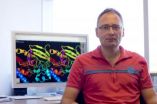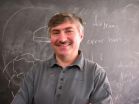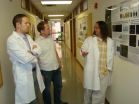(Press-News.org) LA JOLLA, Calif., March 18, 2012 – Autoimmune diseases, such as Type I diabetes and rheumatoid arthritis, are caused by an immune system gone haywire, where the body's defense system assaults and destroys healthy tissues. A mutant form of a protein called LYP has been implicated in multiple autoimmune diseases, but the precise molecular pathway involved has been unknown. Now, in a paper published March 18 in Nature Chemical Biology, researchers at Sanford-Burnham Medical Research Institute (Sanford-Burnham) show how the errant form of LYP can disrupt the immune system. In doing so, they also found a potential new therapy for autoimmune diseases—a chemical compound that appears to inhibit this mutant protein.
T cells and autoimmune disease
In Caucasian populations, a mutated form of LYP (short for lymphoid tyrosine phosphatase) is the third most common single-gene cause of Type 1 diabetes. It ranks second for rheumatoid arthritis.
Researchers have known that LYP and another protein called CSK (C-terminal Src kinase) work cooperatively to keep the immune system's destructive T cells from being activated. Because the uncontrolled activation of T cells is a hallmark of many autoimmune diseases, the proper functioning of LYP with CSK is thought to keep T cells in check.
While the normal form of LYP can bind CSK, the disease-associated mutant LYP cannot. In the new study, Sanford-Burnham researcher Lutz Tautz, Ph.D. led an international group of scientists in showing that normal LYP can disassociate itself from CSK, which paradoxically makes LYP better at dampening the signals that activate T cells. These findings explain why the mutant form of LYP is better at limiting T cell activation than normal LYP.
"It's still a mystery how a protein that impairs T cell signaling causes autoimmunity," said Tautz. "In a simple model of autoimmunity, you would think the opposite."
One possible explanation, Tautz said, is that the mutant LYP weakens the action of regulatory T cells, which control the other type of T cells, the kind that causes autoimmunity.
"If you have regulatory T cells that are not as active because they have inhibited signaling, then they might not be able to do their job properly," Tautz said.
Towards new therapeutics
In their study, the researchers also screened 50,000 drug-like chemical compounds and found 33 that have a specific effect on LYP activity. One compound, called LTV-1, blocked the action of the mutant LYP protein in human T cells. In fact, under physiological conditions, LTV-1 is the most potent LYP inhibitor reported to date.
Tautz said he plans to next develop the LTV-1 compound further, in part by modifying it chemically to make it more effective as a drug. Tests in mice, however, could be problematic because a separate study recently showed that mice with a corresponding LYP mutation don't get sick at all.
Developing new treatments for autoimmune diseases would help millions of people. Overall, autoimmune diseases affect more than 25 million individuals in the United States alone. According to the U.S. Department of Health and Human Services, autoimmune diseases are a leading cause of death and disability.
INFORMATION:
This research was funded by the National Cancer Institute, the Norwegian Cancer Society, the American Cancer Society, the Oxnard Foundation, the Belgian Research National Scientific Fund, and Liege University.
The study was co-authored by Torkel Vang, Sanford-Burnham and University of Oslo; Wallace H. Liu, Sanford-Burnham; Laurence Delacroix, Liege University; Shuangding Wu, Sanford-Burnham; Stefan Vasile, Sanford-Burnham; Russell Dahl, Sanford-Burnham; Li Yang, Sanford-Burnham; Lucia Musumeci, Liege University; Dana Francis, Brown University; Johannes Landskron, University of Oslo; Kjetil Tasken, University of Oslo; Michel L. Tremblay, McGill University; Benedicte A. Lie, University of Oslo; Rebecca Page, Brown University; Tomas Mustelin, Sanford-Burnham; Souad Rahmouni, Liege University; Robert C. Rickert, Sanford-Burnham; and Lutz Tautz, Sanford-Burnham.
About Sanford-Burnham Medical Research Institute
Sanford-Burnham Medical Research Institute is dedicated to discovering the fundamental molecular causes of disease and devising the innovative therapies of tomorrow. The Institute consistently ranks among the top five organizations worldwide for its scientific impact in the fields of biology and biochemistry (defined by citations per publication) and currently ranks third in the nation in NIH funding among all laboratory-based research institutes. Sanford-Burnham is a highly innovative organization, currently ranking second nationally among all organizations in capital efficiency of generating patents, defined by the number of patents issued per grant dollars awarded, according to government statistics.
Sanford-Burnham utilizes a unique, collaborative approach to medical research and has established major research programs in cancer, neurodegeneration, diabetes, and infectious, inflammatory, and childhood diseases. The Institute is especially known for its world-class capabilities in stem cell research and drug discovery technologies. Sanford-Burnham is a U.S.-based, non-profit public benefit corporation, with operations in San Diego (La Jolla) and Santa Barbara, California and Orlando (Lake Nona), Florida. For more information, please visit our website (www.sanfordburnham.org) or blog (http://beaker.sanfordburnham.org). You can also receive updates by following us on Facebook and Twitter.
New insight into mechanisms behind autoimmune diseases suggests a potential therapy
Sanford-Burnham study shows how the breakup of 2 proteins interferes with the immune system and demonstrates that inhibiting 1 of the errant proteins restores proper function
2012-03-19
ELSE PRESS RELEASES FROM THIS DATE:
UMass Amherst theoretical physicists find a way to simulate strongly correlated fermions
2012-03-19
AMHERST, Mass. – Combining known factors in a new way, theoretical physicists Boris Svistunov and Nikolai Prokof'ev at the University of Massachusetts Amherst, with three alumni of their group, have solved an intractable 50-year-old problem: How to simulate strongly interacting quantum systems to allow accurate predictions of their properties.
It could open the door to practical superconductor applications, as well as to solving difficult "many-body" problems in high-energy physics, condensed matter and ultra-cold atoms.
The theoretical breakthrough by Prokof'ev and ...
Improving Your Doctor's Hygiene
2012-03-19
When people don't feel well, they see a doctor. They probably assume that the doctor will not spread anything to them to make them sicker. Ohio residents may be disturbed to find out that hygiene in hospitals is not as high of a priority as one would expect.
Hospital-acquired infections are the fourth leading cause of death in the United States. A 2004 study done by the American College of Physicians found that only 57 percent of doctors washed their hands when they were supposed to. The study also showed that the busier the doctor was and the more patients needing ...
Columbia Engineering and Penn researchers increase speed of single-molecule measurements
2012-03-19
New York, NY—March 18, 2012—As nanotechnology becomes ever more ubiquitous, researchers are using it to make medical diagnostics smaller, faster, and cheaper, in order to better diagnose diseases, learn more about inherited traits, and more. But as sensors get smaller, measuring them becomes more difficult—there is always a tradeoff between how long any measurement takes to make and how precise it is. And when a signal is very weak, the tradeoff is especially big.
A team of researchers at Columbia Engineering, led by Electrical Engineering Professor Ken Shepard, together ...
A surprising new kind of proton transfer
2012-03-19
When a proton – the bare nucleus of a hydrogen atom – transfers from one molecule to another, or moves within a molecule, the result is a hydrogen bond, in which the proton and another atom like nitrogen or oxygen share electrons. Conventional wisdom has it that proton transfers can only happen using hydrogen bonds as conduits, "proton wires" of hydrogen-bonded networks that can connect and reconnect to alter molecular properties.
Hydrogen bonds are found everywhere in chemistry and biology and are critical in DNA and RNA, where they bond the base pairs that encode genes ...
Genetic variation in East Asians found to explain resistance to cancer drugs
2012-03-19
DURHAM, N.C., AND SINGAPORE – A multi-national research team led by scientists at Duke-NUS Graduate Medical School has identified the reason why some patients fail to respond to some of the most successful cancer drugs.
Tyrosine kinase inhibitor drugs (TKIs) work effectively in most patients to fight certain blood cell cancers, such as chronic myelogenous leukemia (CML), and non-small-cell lung cancers (NSCLC) with mutations in the EGFR gene.
These precisely targeted drugs shut down molecular pathways that keep these cancers flourishing and include TKIs for treating ...
Exotic materials will change optics, Duke researchers say
2012-03-19
DURHAM, N.C. -- Duke University engineers believe that continued advances in creating ever-more exotic and sophisticated man-made materials will greatly improve their ability to control light at will.
The burgeoning use of metamaterials in the field of optics does not rely on the limited set of materials found in nature, but rather man-made constructs that can be designed to control light's many properties. This control is gained by use of metamaterials, which are not so much single substances but entire man-made structures that can be engineered to exhibit properties ...
Special Safety Issues Facing Older Drivers and Pedestrians
2012-03-19
As we most of us already know, aging usually means we'll experience more problems with our hearing, vision and motor skills. In order to grow older safely, we must first recognize our vulnerabilities. Once we do this, we can adapt our behavior in order to create a safer environment for ourselves and everyone else.
The following statistics shed light on the special safety issues facing seniors both behind the wheel and when walking around as pedestrians.
Safety Issues for Senior Drivers/Pedestrians
(Note: In 2009, approximately 40 million Americans were age 65 and ...
Bone marrow transplant arrests symptoms in model of Rett syndrome
2012-03-19
A paper published online today in Nature describes the results of using bone marrow transplant (BMT) to replace faulty immune system cells in models of Rett Syndrome. The procedure arrested many severe symptoms of the childhood disorder, including abnormal breathing and movement, and significantly extended the lifespan of Rett mouse models. Exploring the function of microglia deficient in methyl-CpG binding protein 2 (Mecp2), the protein encoded by the "Rett gene," principal investigator Jonathan Kipnis, Ph.D. and his team at the University of Virginia School of Medicine ...
The Viking journey of mice and men
2012-03-19
House mice (Mus musculus) happily live wherever there are humans. When populations of humans migrate the mice often travel with them. New research published in BioMed Central's open access journal BMC Evolutionary Biology has used evolutionary techniques on modern day and ancestral mouse mitochondrial DNA to show that the timeline of mouse colonization matches that of Viking invasion.
During the Viking age (late 8th to mid 10th century) Vikings from Norway established colonies across Scotland, the Scottish islands, Ireland, and Isle of Man. They also explored the north ...
The Japanese traditional therapy, honokiol, blocks key protein in inflammatory brain damage
2012-03-19
Microglia are the first line defence of the brain and are constantly looking for infections to fight off. Overactive microglia can cause uncontrolled inflammation within the brain, which can in turn lead to neuronal damage. New research published in BioMed Central's open access journal Journal of Neuroinflammation shows that, honokiol (HNK) is able to down-regulate the production of pro-inflammatory cytokines and inflammatory enzymes in activated microglia via Klf4, a protein known to regulate DNA.
Scientists from the National Brain Research Centre, Manesar, India, used ...
LAST 30 PRESS RELEASES:
Archaeologists use AI to create prehistoric video game
Mitochondria migrate toward the cell membrane in response to high glucose levels
Tiny viral switch offers hope against drug-resistant bacteria
Most parents aware of early peanut introduction guidelines, but confused about details
HPV vaccine can protect against severe lesions of the vulva and vagina
Virtual care provision and emergency department use among children and youth
Quadrivalent HPV vaccine and high-grade vulvovaginal lesions
Insights into dry eyes gained from stem cell-derived tear glands
Researchers identify 166 human pluripotent stem cell lines available for use in clinical applications
Europa Clipper instrument uniquely observed interstellar comet 3I/ATLAS
UN University Report challenges climate change as sole trigger of Syrian Civil War, exposing governance failures in drought response
Real estate investment trust (REIT) acquisition associated with hospital closure and bankruptcy
New Raman imaging system detects subtle tumor signals
Boston Children’s receives a $7.5 million grant from Aligning Research to Impact Autism (ARIA) to provide clinical research coordination for the IMPACT Network
Spray-on antibacterial coating offers new protection for plants against disease and drought
ESMT Berlin study: What makes a first offer successful in negotiations
Groundbreaking ceremony marks the beginning of CTAO-South Array construction in Chile
Why swearing makes you stronger
What prevents more cancer patients from enrolling in potentially life-saving clinical trials?
UK’s worst-case climate risks laid bare for lawmakers
A decline in churchgoing linked to more deaths of despair
TAMEST announces Maralice Conacci-Sorrell, Ph.D., UT Southwestern Medical Center, as 2026 Mary Beth Maddox Award & Lectureship Recipient
Global study to evaluate whether dengue outbreaks can be anticipated earlier
Chonnam National University researchers propose innovative voltage-loop control for power factor correction
Accelerating next-generation drug discovery with click-based construction of PROTACs
Detecting the hidden magnetism of altermagnets
$7M gift supports health research, engineering and athletics at UT San Antonio
NU-9 halts Alzheimer’s disease in animal model before symptoms begin
Hospitals acquired by real estate investment trusts associated with greater risk of bankruptcy, closure
City of Hope scientists study rare disorder to uncover mechanism and hormone regulation underlying fatty liver disease and sweet aversion
[Press-News.org] New insight into mechanisms behind autoimmune diseases suggests a potential therapySanford-Burnham study shows how the breakup of 2 proteins interferes with the immune system and demonstrates that inhibiting 1 of the errant proteins restores proper function





